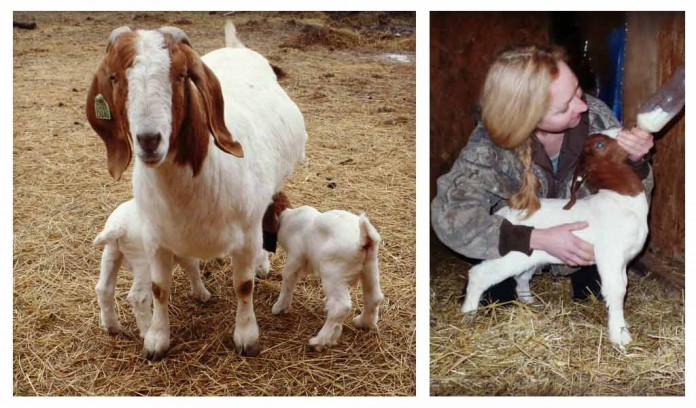Milk is kids’ and lambs’ only source of nutrition at the beginning of life. Weaning is the process of removing milk or milk replacer from the diet, and transitioning to a pasture-based or grain-based diet.
When to wean: Age vs. weight
Weaning kids and lambs when they are 60-90 days old is standard procedure for most goat and sheep producers. At my farm we used to wean kids as soon as they hit the 3-month mark, but we noticed kids from triple births looked runty compared to single and doubles of the same age. We conducted an experiment, weaning triplets based on weight instead of age, to achieve greater gains. The experiment was a huge success. Now we wean all kids on a weight-based model.
More about small ruminants:
FAMACHA scoring to identify parasite risk in small ruminants
Weight-based weaning delays removing milk from the diet until kids and lambs are 3 times their birth weight. An average Boer goat kid, born weighing 8.5 lbs., could be weaned at 25.5 lbs.
7 additional factors to consider
Health condition. This spring, one of our wethers had a bad case of scours. He fully recovered with time and TLC, but lost weight because cause of his condition. We took his health into consideration and delayed weaning until his gains were back on track.
To reduce stress all animals should have completed health management tasks prior to weaning: wormed, castrated, tagged, tattooed, etc.
Diet. Kids and lambs should be consuming grass, hay or feed regularly before they are weaned. As weaning target nears you may notice dams “kicking” kids off more often than allowing them to nurse.
Creep feeding with high-protein feed during weaning supplements small ruminant nutrition and encourages growth.

Parasites. Fresh weaned kids and lambs are highly susceptible to worms on spring pastures. You can reduce parasite burden by finishing kids and lambs on grain and hay.
Forage availability. Our winter birthing season begins January 1. There may or may not be sufficient cool-season grasses and forbs available when time comes to wean in early spring. Make sure spring pastures can support fresh weaned small ruminants.
Predators. Young kids and lambs are most vulnerable to predator attacks. A pack of coyotes can take out an entire herd or flock. Evaluate the risk of removing kids and lambs from their protective dams if predators are a problem.
Performance notes. Some producers wean early to increase feed consumption and encourage rapid growth.
Management. Late weaning works well with less intensely managed herds and flocks; it is less labor intensive and less stressful for man and beast.
Tips to reduce stress during weaning
- Some producers reduce dams’ grain ration and water consumption to help draw down milk production prior to weaning. You may feed dams lower quality hay at this time.
- Kids and lambs should be consuming grass, hay, grain and water on their own before removing milk from their diet. You may feed kids higher quality hay at this time.
- When separating the young from dams, keep young in a familiar setting and move dams to a different location.
- Some crying and stress over new living arrangements is normal and will subside. Watch for serious signs of stress. In kids, watch for excessive weight loss and disinterest in food or water. In dams, watch for excessive udder swelling and redness, obvious discomfort and lethargy. If udder appears engorged, milk the dam to relieve pressure, but do not milk her completely dry.














I like this page. Because I’m emerging farmer and need to know more about breeding livestock